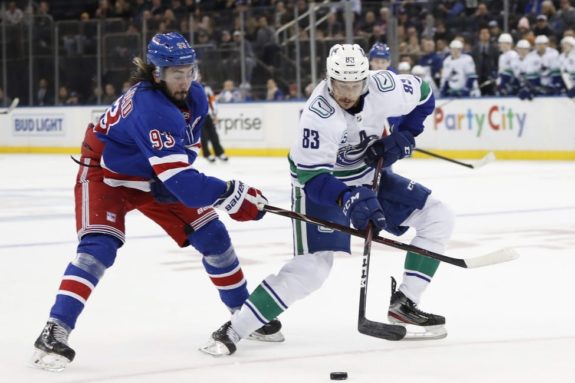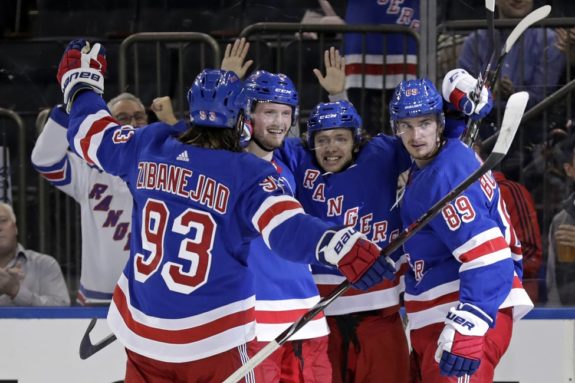The New York Rangers were defeated by the Vancouver Canucks in a Sunday matinee game on Oct. 20, by a score of 3-2. After it all seemed lost at the end of the first period, the Rangers improved to make it a game.
Coming into the matchup, the Rangers were losers of three straight and desperately looking to get back into the win column. The Canucks were coming off of a match against the New Jersey Devils just the day before, which they lost 1-0.
Here are some takeaways from the game.
Horrendous Start, Amazing Finish
The Rangers were on their heels for a majority of the first period. With their backs against the wall, the Canucks had an incredible amount of shots on Henrik Lundqvist. There was a significant difference between the two teams, as the Rangers were sloppy and unorganized. By the end of it, the Rangers had 22 giveaways and each one was costly.
The Rangers conceded a power-play goal, an even-strength goal and then a shorthanded goal in the first, to go down 3-0. The power-play goal, scored by Canucks captain Bo Horvat, was a simple pass to the “bumper” player (Horvat) for a quick shot in the slot. Lundqvist wasn’t able to step up and challenge the shooter, and it was a relatively easy goal. Then, at even strength, back-to-back turnovers by Brendan Smith and Marc Staal gave Brock Boeser a prime scoring chance, and he took full advantage of it.
Finally, to cap off the awful period, Jay Beagle was able to capitalize on a turnover in the offensive zone by rushing it up the ice to beat Lundqvist on his glove side for a shorthanded goal. Mika Zibanejad had a good stick lift on him, but Beagle was able to outmuscle him for the goal.

Those three goals sucked the air out of Madison Square Garden, as it seemed like the Canucks score doubled that. It felt like the score was unreachable for the Rangers.
The Rangers got one back in the second to make it a 3-1 game. The Canucks still won the period, with consistently skating up-and-down the ice and getting shots on Lundqvist every time they passed the attacking blue line.
The Canucks went on a stretch of seven straight shots on goal in a span of about three minutes in the second period. The Rangers gave away the puck three times during that segment. They were very careless with the puck, and their opponents took advantage of it.
It was complete domination from the Rangers in the third period. Down 3-1, everything was left out on the ice as they nearly mounted the comeback. Artemi Panarin had a quick one-timer go past Jacob Markstrom in the third period, and it gave the team some life. In the end, the difference was too vast, and they couldn’t get it done. Even though they lost the game, that fiery and ferocious third period was the best period of the season. If they can play like that for an entire game, the rest of the NHL doesn’t stand a chance.
During the second half of the third period, the puck was in the offensive zone. The five-on-five play looked more like a power play, and the Rangers had a lot of solid chances. They were able to get shots to the net, and it created scrums in the crease with a loose puck. Unfortunately, they just couldn’t get one past Markstrom, who had 18 saves in the final period.
Player Highlights
Lundqvist was able to settle down after the terrible start to the game. He was able to compose himself and hold the Canucks to just those three goals. He went on to save 40 pucks from entering the net, but the damage was already done. Although he didn’t have a strong first period, he kept the game within reach and it certainly could have been a lot worse than it was.

Staal, who had an up-and-down game, had his worst play of the day after a controversial missed call from the officials. As he went towards the corner boards in the defensive zone to retrieve the puck, Christopher Tanev gave him a shove in the numbers. After the missed hitting-from-behind call, he decided to take revenge on Tanev with a crosscheck that broke his own stick and got him two minutes in the penalty box. Over the course of the season, it seems that Staal has had moments of stellar positive play, but they have been coupled with a lackluster one, just moments later.
After an impressive takeaway from Jesper Fast and then a pass from Ryan Strome, Jacob Trouba was able to fire it on goal from near the blue line. Fast was then able to skate in front of the opposing goaltender and get a tip on the puck to get the Rangers on the board. He now has two goals on the season, and Trouba picked up his fifth assist.
Panarin, who continues to show that he is worth every single penny of his contract, was able to get one past Markstrom. All four of his goals this season have had Zibanejad attached to it with an assist. In all six games of the season, the first-line left winger and center have had unbelievable chemistry. They have been able to find each other for breakouts and complemented the others speed down the ice. There is still a full season to go, and they are getting better with each other with every passing game.

More Changes
Another change came from head coach David Quinn, one that many fans have been hoping for since the regular season began. Kaapo Kakko was bumped up to the first power-play unit and Pavel Buchnevich slid down to the second unit.
This was going to happen sooner-or-later. The first power-play unit consisting of Panarin, Zibanejad, Buchnevich, Trouba and Chris Kreider had gone from 3-for-5 in the first two games of the season, to a dismal 1-for-17. With Kakko at the right circle, the switch seemed to look better despite not registering a goal with the man-advantage. Keeping him on the top unit will only benefit him, as he has shown some growing pains at both even strength and on the power play.
Buchnevich had some redeeming moments toward the end of this game. After being demoted from the first line to the second, to then the third or even fourth line at times, he was out there for the empty-net situation with under two minutes to go. He used his stick to deflect a for-sure goal from going in, then gathered the puck to go up the ice and had a great chance to score the game-tying goal. He was tripped up trying to drive toward the net and wasn’t able to get the shot off, and again, there was no call on the play.
What to Make of It
This went from being a game to forget, to a game to remember for the Rangers. At the first intermission, it seemed like the game was completely lost, and there wasn’t any chance of a comeback. This lasted until the Fast goal. From that point on, they looked like a completely different hockey team.
Going forward, the Rangers will have to play a complete game. Instead of just showing up in the final 20 minutes, they need to perform in the entire 60. At 2-4-0 on the season, with four points, they sit in 28th place in the NHL and at the bottom of the Metropolitan Division. The only place they can really go from here is up.
To coincide with being outshot and stuck inside their own zone for a majority of the game, the Rangers were also losers at the faceoff dot. Coming into the game, they had the second-highest faceoff win percentage in the NHL at 54.2%. At the end of it, they dropped all the way down to ninth after only winning 33% of the draws against the Canucks. The biggest culprit of that was Zibanejad, who only won 29% of his draws as the first-line center.

You can expect some more line changes to take place before the Oct. 22 meeting with the Arizona Coyotes. The top-six forwards should remain the same, but the bottom-six forwards will likely shuffle around. Additionally, the defense is a candidate for change as well. Finally, after taking four of the first six games, Lundqvist is likely to sit out the next game and Alexandr Georgiev may get his third start of the season.
I wouldn’t look at this game as being the worst of the season. Going down 3-0 at the end of the first period is a steep hill to climb, but the Rangers showed an incredible amount of heart. With nothing to lose and everything to gain, they put together a solid 20 minutes of hockey to finish the game. It was an extraordinary showing and a complete turnaround.